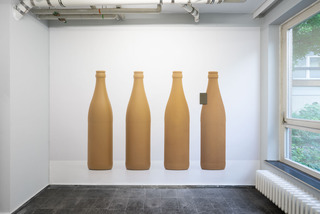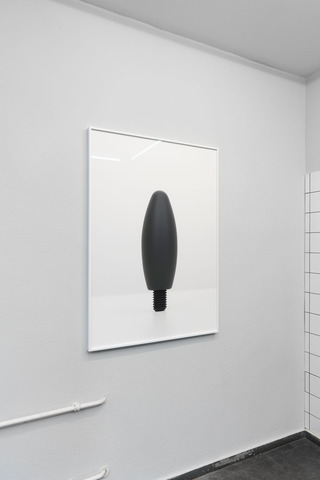Carsten Becker
Show Continental Colors
Continental Colors
Carsten Becker & Willem Besselink
Haunt, Kluckstraße 23, 10785 Berlin
May 28 – June 19, 2021







The gaze is turned westward: the colours of Los Angeles, where the exhibition will be on view in 2022, mix into the continental European climate. In the exhibition Continental Colors, Carsten Becker looks at the implications of the German colour collection RAL and the American hue Olive Drab. Willem Besselink investigates the imaginary colours mentioned in the literature of the “Golden State” California.
For Renaissance artist Giorgio Vasari, colore was nothing without disegno, the concept. Becker’s and Besselink’s colours are based on the disegno of the civilizational: regulations, norms and systems. Both artists decontextualize colour from its historic, literary and emotional purpose, in search of the logics of these contexts. In their works, they make us experience how civilizational concepts interact with us.
Becker researches the German DIN catalogue of industrial standards and the RAL colour collection that standardize machine parts, materials, and colours since 1917 and 1925, respectively. Seemingly aiming at economic efficiency only, both DIN and RAL did have a great impact on the two World Wars. In times of war, when resources are scarce, standard parts provide advantages in both production and time. Standardized colours, like Dunkelgelb (Dark yellow), introduced in the German armed forces in 1943, and Olive Drab, the camouflage colour of the U.S. Army, shaped the war. During World War II, soldiers disguised in this way were facing each other in the deserts of Northern Africa.
In his series Romankleuren (Novel colours), Besselink processes colours mentioned in novels written and set in Los Angeles. He uses self-created sets of rules as vehicles to make them comprehensible and tangible, physically as well as visually. Thus, his drawings result into a coded network of coloured lines, whose angles change with each chapter. In his paintings Besselink translates the poetics of imaginary colours into quantifiable colour blocks. Finally, orange ribbons, derived from Karen Tei Yamashita's novel Tropic of Orange (1997), span the exhibition space and superimpose the architectural system.
Becker and Besselink take history and literature, extract the colours and dissect their symbolic power. By arranging the colours into new forms and media, they offer an immediate visual access to the exhibited works and their inherent systematics. Sensory impressions and contexts, otherwise hardly separate in our perception, can thus be confronted with each other: The upright cardan joint no longer seems just that, after the colour Reinorange (Pure orange) has been identified as the corps colour of the military police Feldjäger, and the standardization of parts as having military purpose. In Besselink’s drawing, the optimistic radiance of golden lines turns brittle as soon as we realize that Ben H. Wintersʼ underlying novel Golden State (2018) is about a dystopian surveillance state.
Der Blick geht nach Westen: Die Farben von Los Angeles, wo die Ausstellung 2022 zu sehen sein wird, mischen sich ins kontinentaleuropäische Klima. In Continental Colors widmet sich Carsten Becker den Implikationen deutscher RAL-Farben und des amerikanischen Olive Drab. Willem Besselink erforscht die imaginativen Farben in der Literatur des „Golden State“ Kalifornien.
Für den Renaissancekünstler Giorgio Vasari war colore nicht vorstellbar ohne disegno, das Konzept. Beckers und Besselinks Farben liegt das disegno des Zivilisatorischen zugrunde: Regularien, Normen und Systeme. Die beiden Künstler dekontextualisieren die Farben von ihrem historischen, literarischen, emotionalen Gebrauch und spüren so deren kontextuellen Logiken nach. Sie machen in ihren Werken erfahrbar, wie die zivilisatorischen Konzepte mit uns interagieren.
Becker untersucht die deutschen Normenkataloge DIN und RAL, die seit 1917 und 1925 unter anderem Maschinenteile, Materialien und Farben standardisieren. Scheinbar pure wirtschaftliche Effizienz zum Ziel, waren beide von großer Bedeutung für die Weltkriege. Normteile konnten in ressourcenknappen Kriegszeiten den entscheidenden Produktions- und Zeitvorteil verschaffen. Standardfarben wie Dunkelgelb, 1943 in der Wehrmacht eingeführt, und Olive Drab, Camouflage der US-Armee, prägten den Krieg. In der nordafrikanischen Wüste standen sich die so getarnten Soldaten während des Zweiten Weltkriegs gegenüber.
In seiner Serie Romankleuren verarbeitet Besselink Farben aus Romanen, die in Los Angeles geschrieben und angesiedelt sind. Selbsterschaffene Regelwerke dienen ihm als Vehikel, um sie physisch und visuell begreifbar zu machen. So entsteht in seinen Zeichnungen ein codiertes Geflecht farbiger Linien, deren Einfallwinkel sich mit jedem Kapitel ändert. Auf Leinwand übersetzt Besselink die Poetik der imaginativen Farben in quantifizierbare Farbblöcke. Orangene Bänder, die den Ausstellungsraum durchspannen, erschaffen schließlich interferierende Systeme zwischen Karen Tei Yamashitas Roman Tropic of Orange (1997) und der sie umgebenden Architektur.
Becker und Besselink nehmen Historie und Literatur, extrahieren daraus Farben und sezieren deren Symbolkraft. In neuer Form von ihnen arrangiert, bietet sich ein unmittelbar visueller Zugang zu den ausgestellten Arbeiten und deren inhärenten Ordnungen. Sinneseindrücke und Kontexte, sonst in unserer Wahrnehmung kaum voneinander zu trennen, lassen sich so miteinander abgleichen: Das aufrechtstrebende Kreuzgelenk scheint nicht mehr dasselbe, nachdem Reinorange als Waffenfarbe der Feldjäger und das Normteil als militärisch nutzbar identifiziert ist. Die optimistische Strahlkraft der goldenen Linien wird brüchig, sobald wir wissen, dass Ben H. Wintersʼ zugrunde liegende Erzählung Golden State (2018) von einem dystopischen Überwachungsstaat handelt.
Anika Reineke, translation: Guus Vreeburg
Serials/Serien
DIN
RAL
JavaScript is turned off.
Please enable JavaScript to view this site properly.